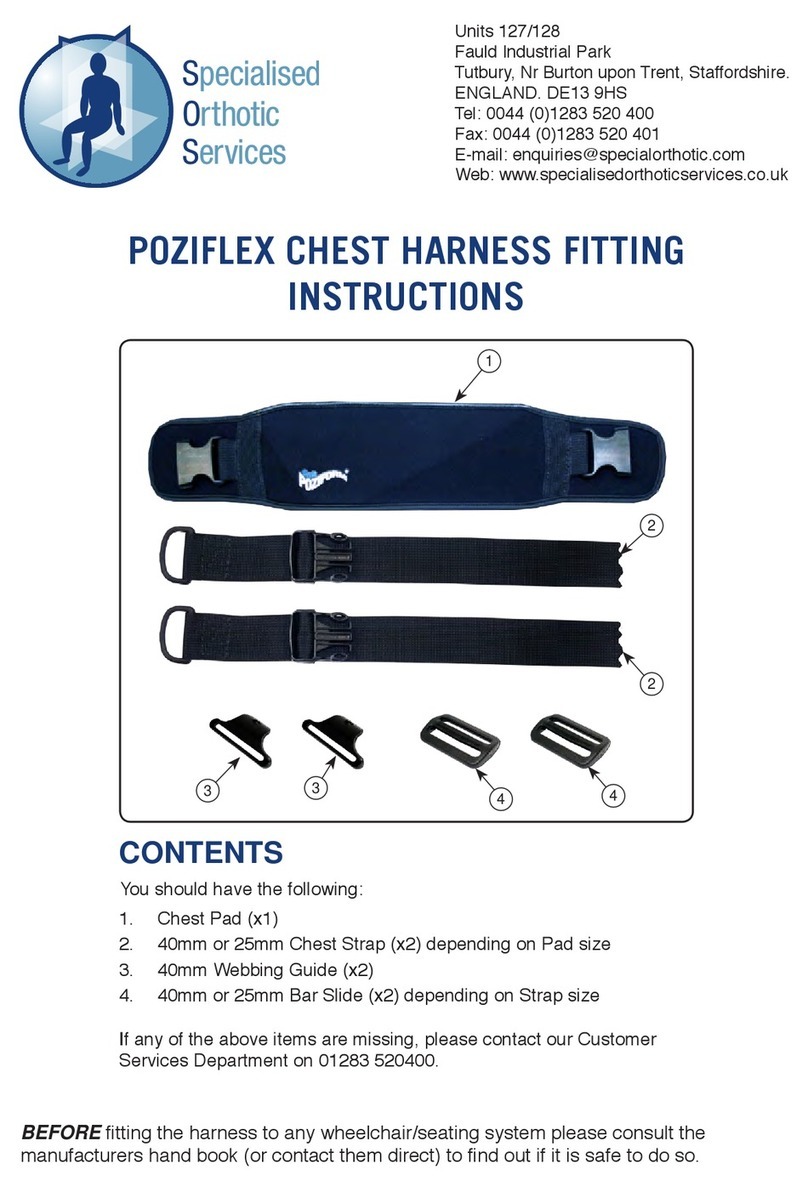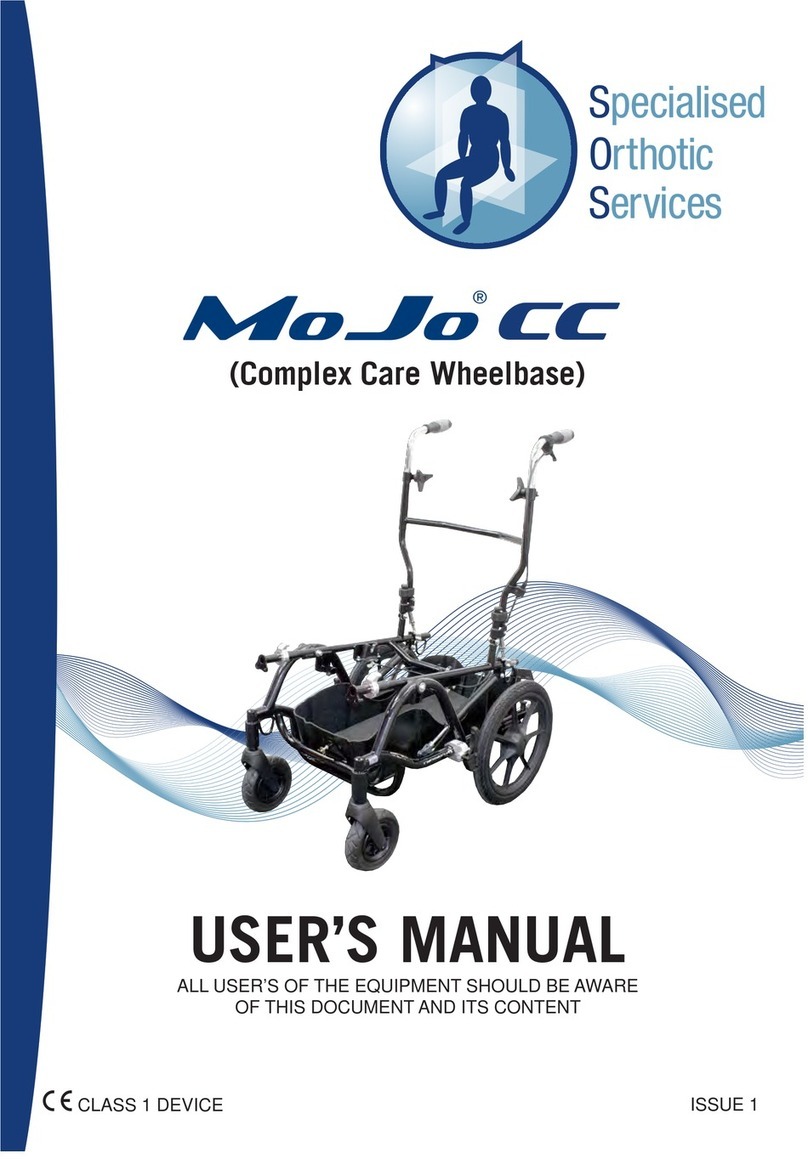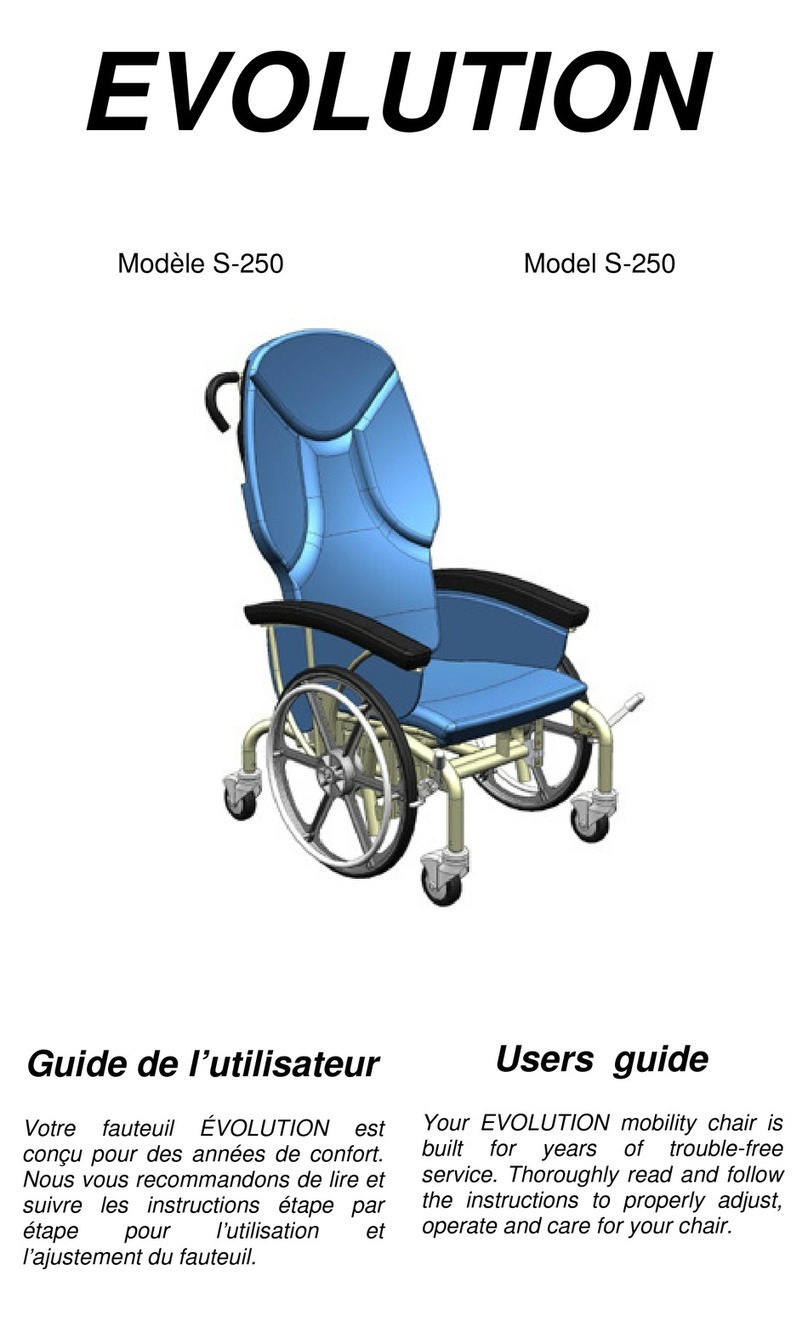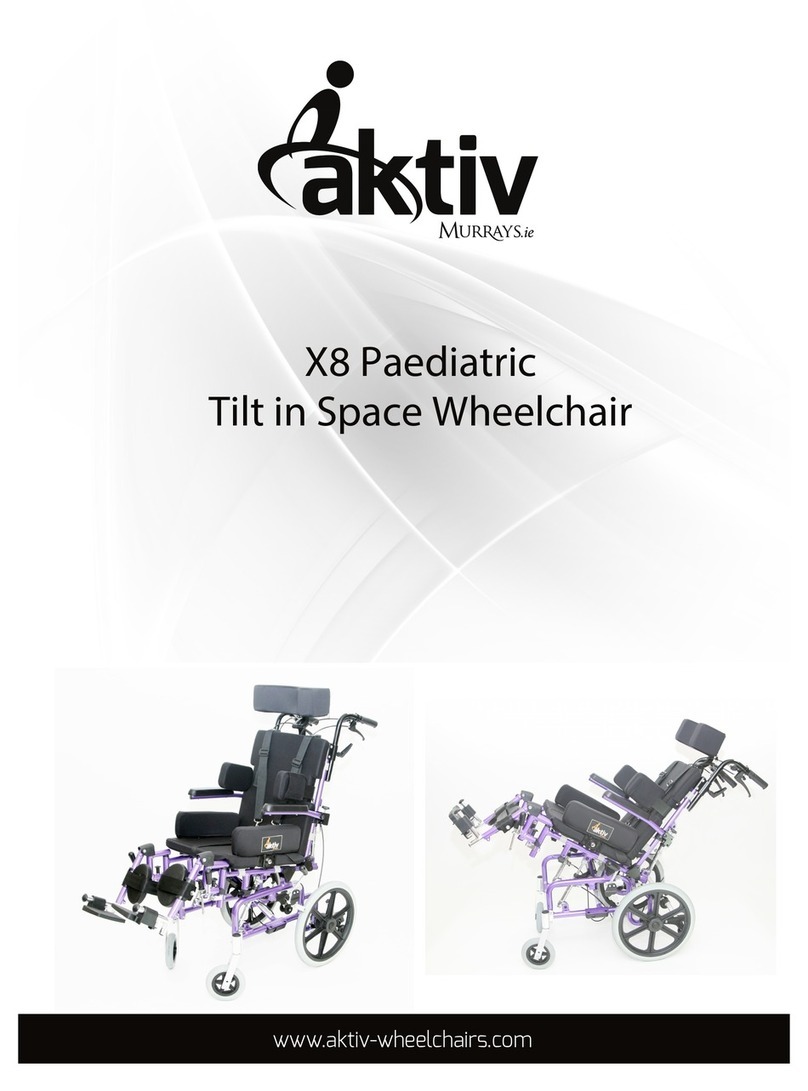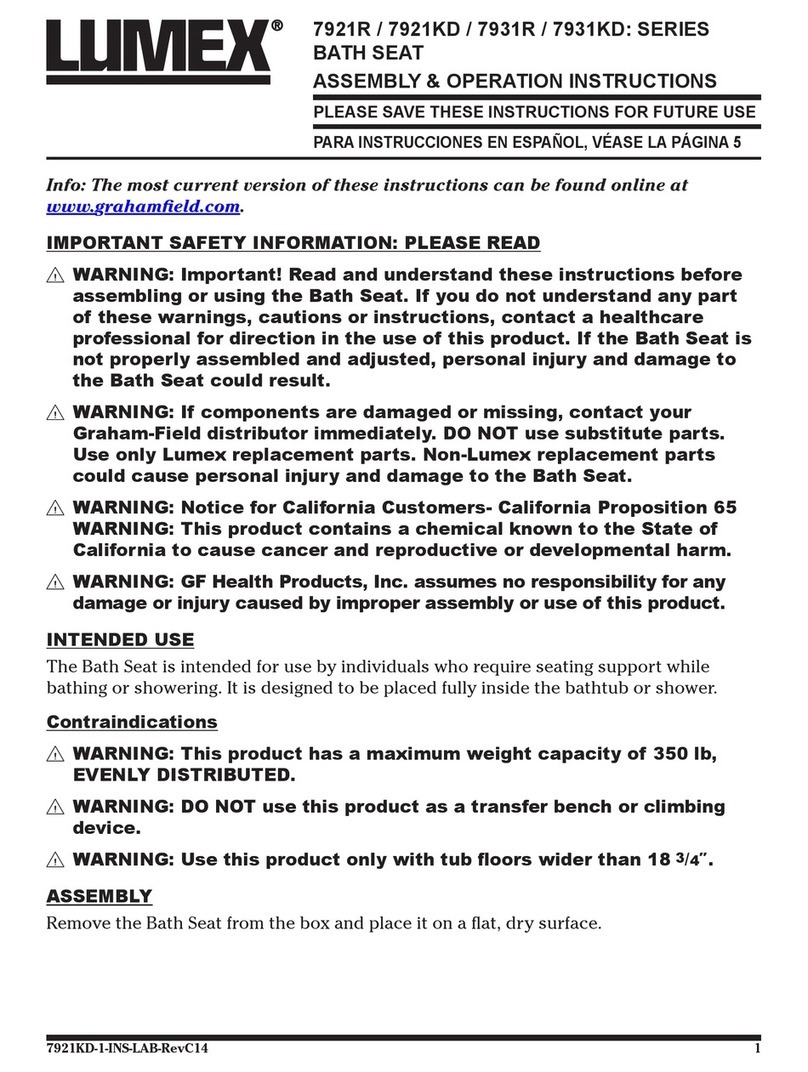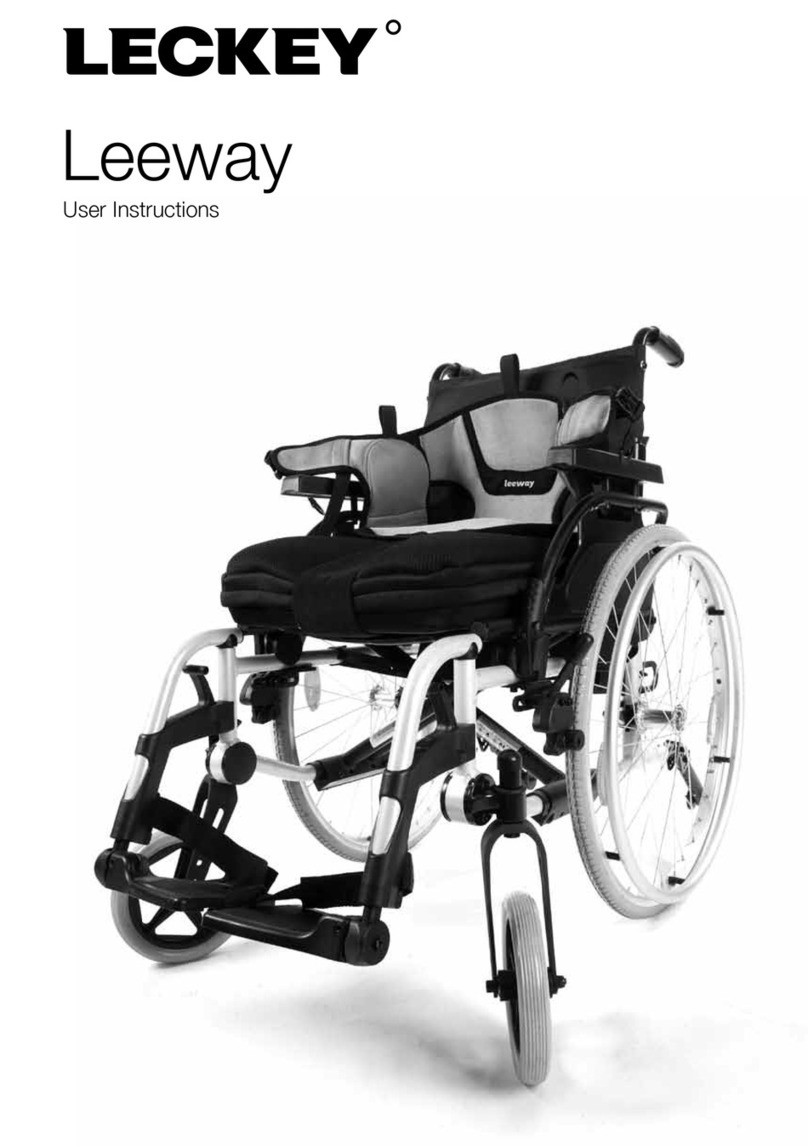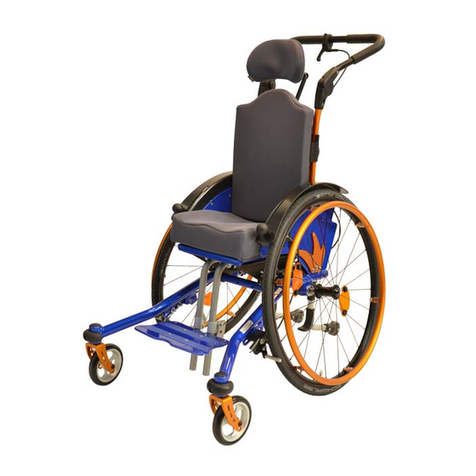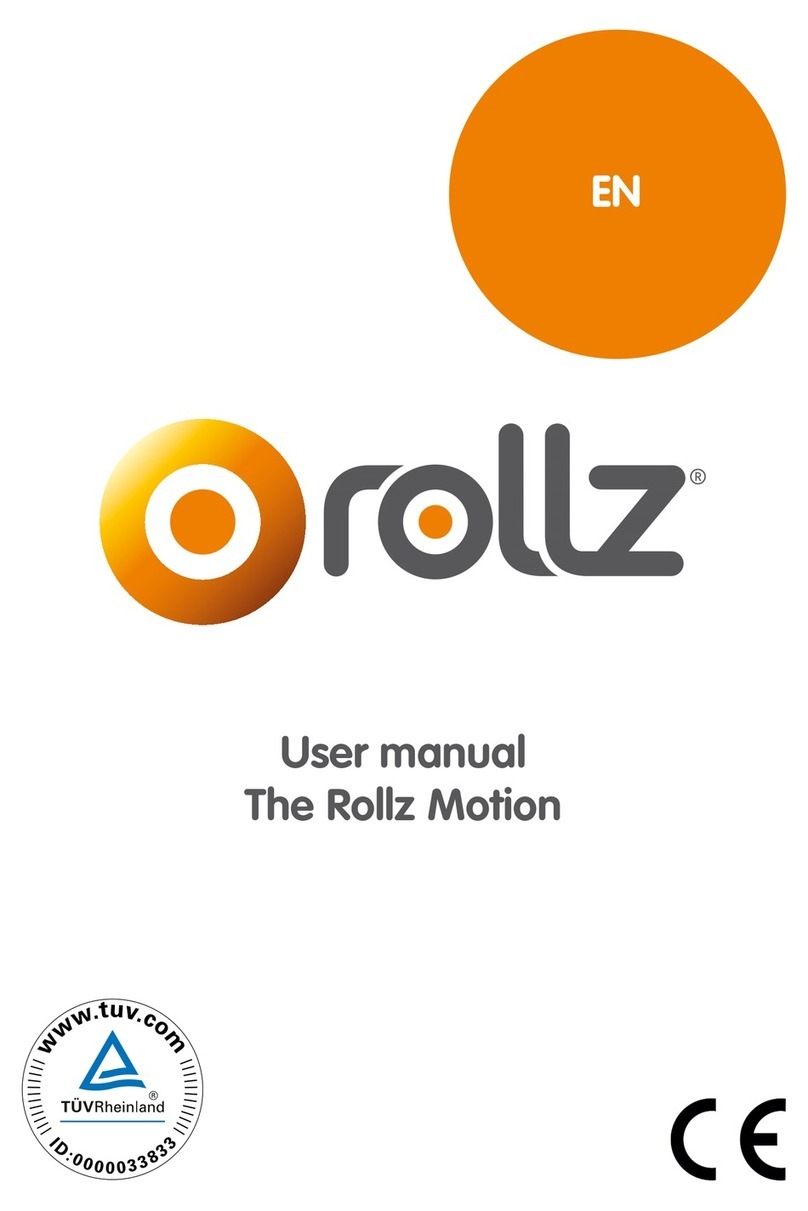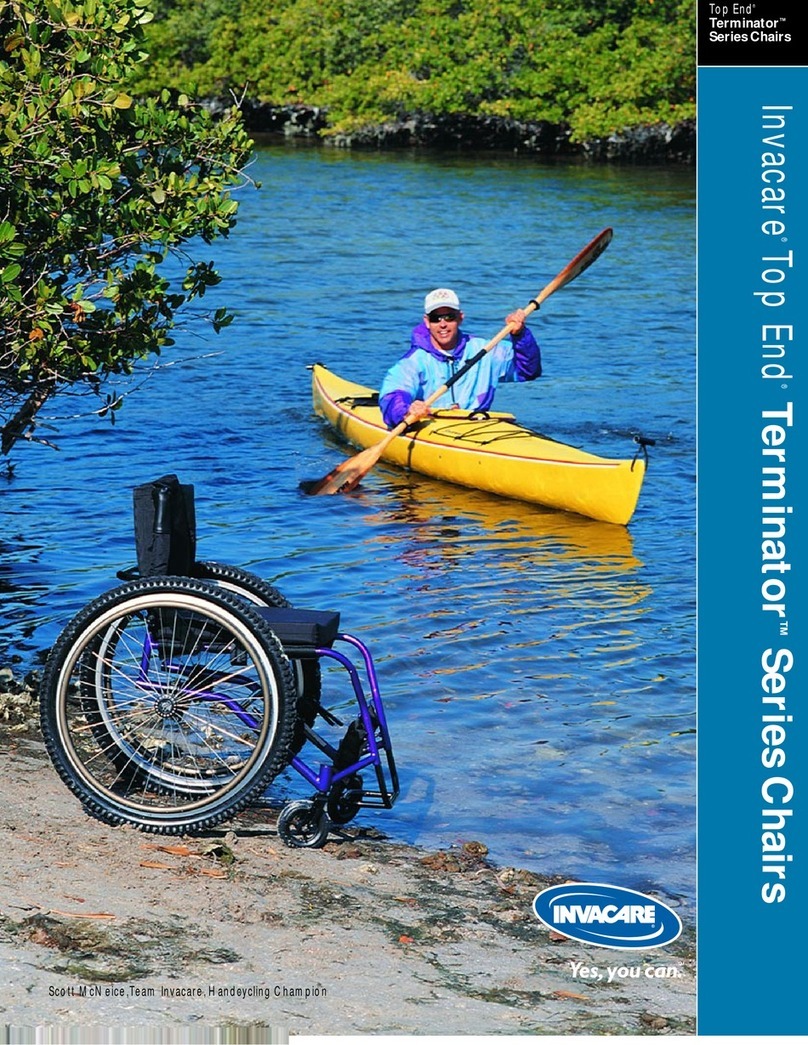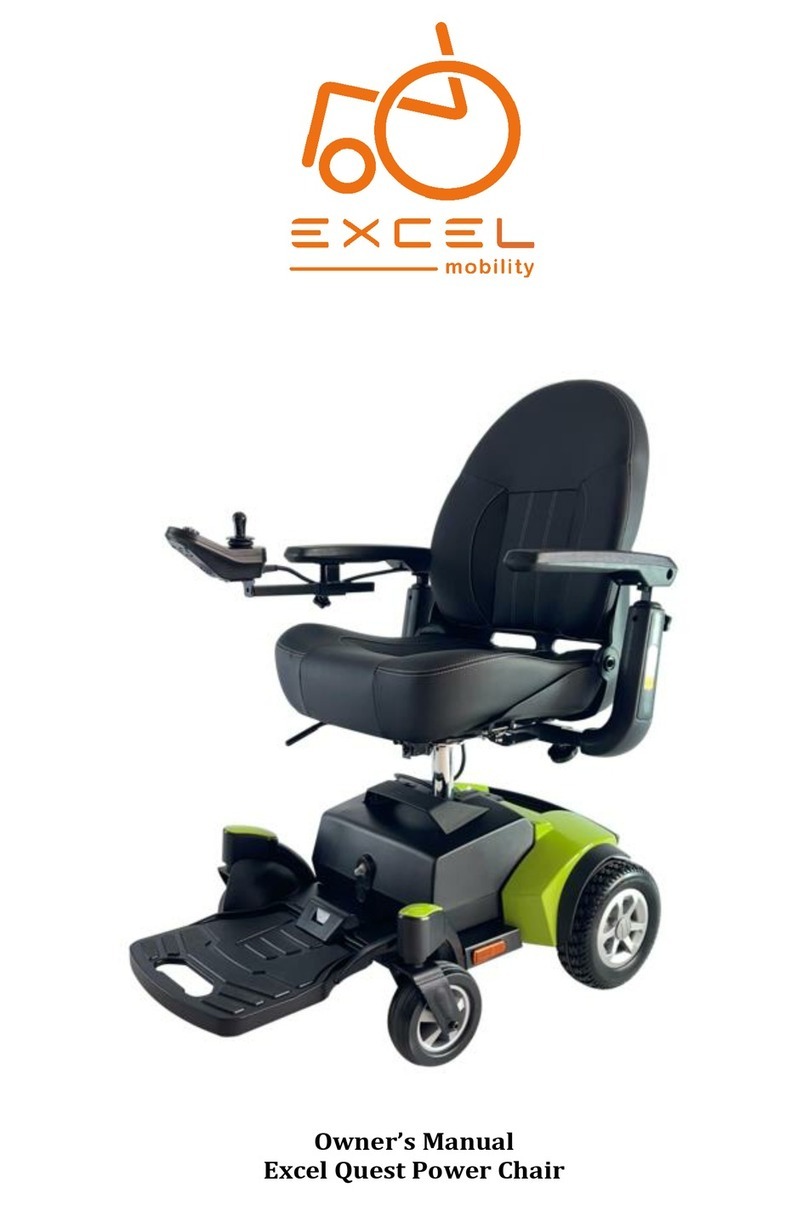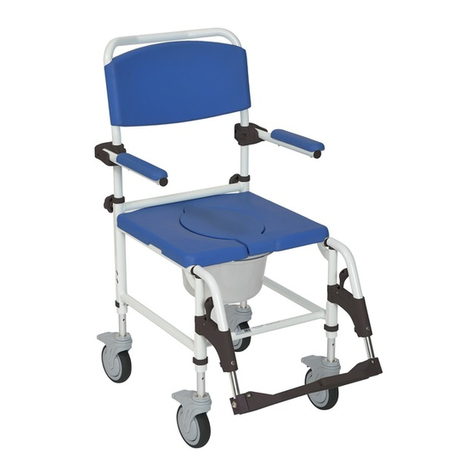Specialised Orthotic Services Miko User manual

USER’S MANUAL
ALL USER’S OF THE EQUIPMENT SHOULD BE AWARE
OF THIS DOCUMENTAND ITS CONTENT
ISSUE 2
Miko
Buggy Wheelbase
|CLASS 1 DEVICE

1
Index
CONTENTS PAGE
Index 1
Introduction & Serial No 2
Stability of Miko and Seating Systems 3
Recommendations on Transport 4
Safety Guidelines for Transportation 5
Transportation 6 - 8
WTORS Manufacturers 8
Key Identication Points 9 & 10
1.0 User’s Guide “Preparing Miko For Use”
1.1 Unfolding the Miko Buggy 11
1.2 Folding the Miko Buggy 11 & 12
1.3 Front Castors 12
1.4 Attaching & Releasing Seating Systems 13
1.5 Seat Tilt Operation 14
1.6 Handle Height Adjustment 14
1.7 Net Carrier Fitting & Removal (If Supplied) 15
1.8 Sunshade/Rain Canopy Fitting & Removal (If Supplied) 16 & 17
2.0 User’s Guide “Placing the Client”
2.1 Seating the Client when Using the Miko Buggy 18
2.2 Removing the Client from the Seating System 18
3.0 User’s Guide “Manoeuvring The Miko”
3.1 Pushing the Miko 19
4.0 User’s Guide “Looking After The Miko”
4.1 Cleaning 20
4.2 Maintenance 20
If You Detect a Fault or Breakage 21
SPECIFICATIONS 22
CONTACT DETAILS Backpage

2
Miko
(Class 1 Device)
Introduction
This• Users Guide for the Miko is designed to give guidance on its use and
maintenance.
The
• Miko is designed to use an SOS interface system when using special seating
systems.
To
• make sure that placing a seating system in the Miko does not render it unstable, it
is recommended that when handing the Miko and seating system over to the client it
istestedforstabilityandaCerticateofComplianceisissuedtoverifythatthelevel
of stability is satisfactory (for more details regarding stability of wheelchair & seating
systems, see page 3).
When
• used in transport the whole system MUSTbesecurelyfastenedtotheoorof
the vehicle (WHEELCHAIR TIE DOWNS) and the vehicles safety belts (OCCUPANT
RESTRAINT)MUST be used in conjunction with the seating systems straps. (See
Guidelines for Transportation on pages 4 - 8)
The
• Mikohasbeentestedtoandconformstothetransportrequirementsasspecied
in ISO 7176-19:2001.
The
• maintenance and safety instructions described in the manual must be adhered
to. By following these instructions you will be ensuring correct use of the Miko and its
safety in use.
It
• is also important to read the ‘Seating System User Manual’ with regard to general
use, transportation use and maintenance.
Serial No.
Each• Miko has a unique Serial Number Plate attached to the inside of the side frames
foridentication.AcopyoftheUniqueSerialNumberisattachedbelowforreference:

3
Stability of Miko and Seating Systems
To• ensure that the Miko Buggy and Seating System are safe to use, it is important
thatttingtheSeatingSystemtotheMikodoesnotmaketheunitunstable.Each
Miko Buggy when handed over to the user should be tested for static stability to the
speciedangleof12degrees(Fig.1).
If
• is also recommended that any
additional items to be used with the
seat and buggy are in place when the
test is done.
The
• stability test is always done
with the client seated in the seating
system and all equipment to be used
by the client on a daily basis when in
the Miko buggy in situ.
Once
• the test has been successfully
completed,aStabilityCerticatewill
be issued by Specialised Orthotic
Services Limited. Acopy of this
certicatewillbehandedoverwhen
the equipment is supplied and should
be kept with the user manual for
future reference.
The
• Miko is not to be used with any
other Seating System(s) than those for which it has been stability tested and
proven safe for use.
Always
• steer clear of obstacles where possible.
When
• using the equipment never attempt to climb or descend an incline where
the surface is rough, wet or slippery (gravel, loose chippings, grass, rain, ice,
snow, etc).
WARNING:
• Whilst the client is seated in the wheelchair, the attachment of any
heavy object to the wheelchair (i.e. shopping bags etc.) will have a serious effect
on the overall stability of the wheelchair and may place the safety of the client at
risk.
12°
Fig.1

4
Recommendations for the
Transportation of SOS Miko’s & Seating Systems
The following information is intended to give guidance with regard to the use of SOS
Miko’s & Seating Systems by wheelchair users and carers during transportation.
Specialised• Orthotic Services Ltd have carried out extensive investigations into
the suitability of the Miko Buggy for transportation use and has established clear
guidelines for users.
Following• these investigations the following user information is intended to give
guidance to users of the Miko Buggy & Seating Systems regarding the use of the
equipment during transportation.
As• part of the assessment process, transportation requirements will be assessed.
This information will be of interest to all parties involved in the daily management of
the wheelchair user (Relatives, Carers, Support Staff, Healthcare Professionals and
Transport Service Providers).

5
General Safety Guidelines for
Wheelchair User Transportation
All wheelchair / buggy users should transfer to vehicle seats whenever possible.•
The• Miko Buggy is designed to be forward facing when used for transportation of the
client in an adapted motor vehicle and users should not travel with the buggy at an
angle or facing sideways to the direction of travel.
There
• shouldbesufcientfreespacearoundthebuggyandusertoavoidthe
user making contact with other vehicle occupants, unpadded parts of the vehicle,
accessories or W.T.O.R.S. anchor points.
It
• is important to apply brakes during transport.
Mobility
• equipment should not block gangways and exits for other passengers in the
vehicle.
A
• headrest should be provided for use when travelling in a vehicle where other seated
passengers have headrests.
Do
• not place / hang any additional items onto the buggy during transportation such as
shopping bags and holdalls.
Trays
• should be removed for transportation and secured separately in the vehicle or
be secured to the buggy but positioned away from the occupant with energy-absorbing
padding placed between the tray and the occupant.
Wheelchair Tie Down and Occupant Restraint System
(W.T.O.R.S.)
Secure methods for the safe retention of mobility equipment have been developed and• are used on a regular basis to secure wheelchairs/buggies during transportation use.
These
• systems are now commonly referred to as W.T.O.R.S.
Wheelchair Tie down and Occupant Restraint Systems
There are many types of W.T.O.R.S. available from various manufacturers; a list of• some manufacturers is given on page 8). Refer to your Seating System Manufacturers
Handbook for details of their particular recommendations.
Please
• note that all lap /chest belts and harnesses supplied with the seating system
are notsufcientforoccupantrestraintwhentheequipmentisusedonamoving
vehicle and additional Occupant Restraint is required.

6
1. TRANSPORTATION
When ever possible the user should be removed from the seating system and secured•
inthevehiclesxedseats.
When
• not in use for transportation the seating system & Miko Buggy should be
disassembledandxedintheluggageareaofthevehicle.
1.1. TRANSPORTATION OF THE CLIENT SEATED IN THE MIKO BUGGY
SEATING UNIT.
Transportation• of the user with the seating system can be done when used
in conjunction with a “Wheelchair Tie down and Occupant Restraint System”
(W.T.O.R.S.). The Miko Buggy has been tested using a 4-point tie down system.
Push
• the wheelchair into the vehicle via a ramp when ever possible.
Apply
• the rear brakes (Fig.1.1a). Please Note: The Miko & seating system can be
safely transported at any angle of tilt as long as the seat belt can be located correctly
over the shoulder.
Attach
• the W.T.O.R.S. to the front tie down points
(Fig.1.1b).
Attach
• the W.T.O.R.S. to the rear tie down points
(Fig.1.1c).
Attach
• apermanentlyxedvehicleseatbelt
around the client and wheelchair.
Please
• refer to the W.T.O.R.S. manufacturers
handbook for correct tting and adjustment
for both the client and passengers safety.
Never
• move the vehicle without applying:
Thei) wheelchair brakes.
Correctly tted & adjusted W.T.O.R.S.ii)
Vehicle seat belt around the client & iii)
wheelchair.
Fig.1.1b Fig.1.1c
Fig.1.1a

7
1.2. WHEELCHAIR TIE DOWN SYSTEM
• Wheelchair users should not travel in cars, taxis or minibuses, unless the
wheelchair is tied down.
Please
• refer to your Miko Buggy & Seating System users guides for information
regarding the recommended wheelchair tie down system to be used.
Only
• theSeatingSystemspeciedforusewiththeMikoBuggycanbeused.
1.3. OCCUPANT RESTRAINT SYSTEM
Wheelchair• users should not travel in cars, taxis or minibuses, unless an
occupant restraint system is in place on the client.
For
• any client to be transported safely in the Seating System and Miko Buggy, it is
essential that an Occupant Restraint System be used.
SOS
• have proven during crash tests on Miko
Buggies (Fig.1.3a) that transporting any client on
a moving vehicle without an approved occupant
restraint system is extremely dangerous and will
place THE CLIENT AT GREAT RISK.
It
• is important that the Occupant Restraint
System is positioned correctly as most clients
using Special Seating will be dependent on
carers for correct placement of the occupant
restraint.
Consideration
• should be given to the most
suitable type and positioning of restraint for the
user, both in normal travel and during an impact.
The
• Occupant Restraint should have a clear
path from the user to the anchor
point (Fig.1.3b), and should not be
held away from the body and should
not be interfered with by any part of
the vehicle, Miko Buggy, seating or
accessory (Fig.1.3c).
Fig.1.3c
RESTRAINTS SHOULD
NOT BE HELD AWAY FROM
BODY BY WHEELCHAIR
COMPONENTS SUCH
AS ARMRESTS
OR WHEELS
Fig.1.3b
PELVIC RESTRAINTS SHOULD
MAKE FULL CONTACT
ACROSS THE FRONT OF
THE BODY NEAR
THE JUNCTION OF
THE THIGH
AND PELVIS
Fig.1.3a

1.4. STOWAGE OF THE MIKO AND SEATING SYSTEM
During• use of your Special Seating System it may be necessary for you to remove the
Seating System and stow this along with the Miko Buggy in a vehicle.
It
• is important to realise that these items pose a risk if not adequately restrained
whilst in transit.
It
• is notadequatetosimplyplacetheitemsintoacarbootortheoorofanopen
vehicle such as an MPV or estate car as in a collision these unsecured items could
cause serious injury to occupants of the vehicle.
Various
• retention methods are available to secure such equipment during transit, and
once again the list of Wheelchair Restraint System Manufacturers in this booklet will
be happy to advise on this matter (see below).
8
W.T.O.R.S MANUFACTURERS
Below are details of some Wheelchair Tie down and Occupant Restraint Systems
manufacturers.
UNWIN SAFETY
SYSTEMS Unwin House
The Horseshoe
Coat Road
Martock
Somerset
TA12 6EY
TEL: 01935 827740
FAX: 01935 827760
E Mail: sales@unwin-safety.co.uk
KOLLER
ENGINEERING LTD Unit 5, Garrett Road
Lynx Trading Estate
Yeovil
Somerset
BA20 2TJ
TEL: 01935 426695
FAX: 01935 433766
E MaiI: enquiries@koller.co.uk
QSTRAINT
(EUROPE) 72 - 76
John Wilson Business Park
Whitstable
Kent
CT5 3QT
TEL: 01227 773035
FAX: 01227 770035

9
2. KEY IDENTIFICATION POINTS
• S.O.S. Miko’s are provided with a tilting frame (Fig.2.1) and a seating system quick
release interface (Fig.2.2 on page 10).
2.1. STROLLER
Fig.2.1 Miko
Push Handle1. Tilt Base2. Wheelbase3. Foot brake4. Front Tie Down Point5.
6. Rear Tie Down Point
Handle Adjustment Button7. Tilt Lever8. Frame Locking Catch9. Interface Location (see page 10)10. Rear Foot Bar11.
2
6
1
9
4
5
3
10
7
8
11

10
Fig.2.2
Seat Frame (not shown)1. Front Location (x2)2. Rear Catch (x2)3. Release Cable4.
2
3
2
3
1
2.3. THE SEATING SYSTEM
Seating• Systems need to be interfaced to the Miko Buggy safely and it is important
that the interface system supplied with the Wheelbase is used.
It
• is recommended that seating systems are attached to the Miko Buggy using an
SOS “Miko Buggy Seat Interface”. (see tech spec for reference and interface product
codes)
Please
• refer to any handbooks supplied with your seating system before attaching any
seat to the Miko Buggy.
2. KEY IDENTIFICATION POINTS (Cont.)
2.2. SEATING SYSTEM INTERFACE
4

11
USER GUIDE 1.0
PREPARING THE MIKO BUGGY FOR USE
1.1. UNFOLDING THE MIKO BUGGY
Place• your foot on the rear bar and pull the push handle upwards (Fig.1.1a), which will
allow the frame to rotate into position.
Make
• sure the locking catches have automatically clicked into position over the frame
(Fig.1.1b).
Fig.1.1a Fig.1.1b
1.2. FOLDING THE MIKO BUGGY
Release• the front castor swivel lock as on page 12 (Fig.1.3b).
Pull
• up both locking catches simultaneously until clear of the frame (Fig.1.2a).
Push
• handle down and let the front frame rotate backwards (Fig.1.2b) until it is folded
up under the rear section and the handle is as far down as it will go (Fig.1.2c).
Fig.1.2a Fig.1.2b

12
Fig.1.2c
1.3. UNLOCKING FRONT CASTOR’S SWIVEL LOCK
Make• sure that the rear brakes are applied to the rear wheels (Fig.1.3a).
Pull
• release pin upwards and rotate through 90° (Fig.1.3b).
To
• lock the swivel on the front castors, rotate the release pin until it drops into the
groove then rotate the castor until the pin drops into the hole on the fork body.
Fig.1.3bFig.1.3a

13
1.4. ATTACHING THE SEAT
Make• sure that the brakes are applied to
the rear wheels (Fig.1.4a).
Locate
• the front of the interface frame
into stops as shown (Fig.1.4b).
Lower
• the interface into the rear catches
as shown until it clicks into position
(Fig.1.4c).
Please
• refer to handbooks supplied
with your seating system for any
additional security devices (i.e.
Retaining Straps) that need to be tted
prior to client use.
RELEASING THE SEAT
Make• sure that the brakes are applied to
the rear wheels (Fig.1.4a).
SOS
• recommends that the client is
always removed from the seating system
before releasing the interface and
removing seats. Never try to lift the
client in the seat system
To
• release the seat pull back the interface
cable (Fig.1.4d) until the catches release,
raise up the rear of the interface clear of
the catches, release the cable and pull
the interface clear of the front stops.
Now
• lift the seat and remove.
Fig.1.4b Fig.1.4c
Fig.1.4d
Fig.1.4a

14
1.5. SEAT TILT OPERATION
Make• sure that the brakes are applied to the rear wheels (Fig.1.5a).
To
• recline the seat in the chassis, squeeze the tilt lever (Fig.1.5b) and push onto the
seating system tilting backwards, until desired angle of tilt is achieved then release the
lever.
To
• raise the seat back to the upright position just press the lever and pull the seat until
required position is achieved. Release lever to lock in position.
1.6. PUSH HANDLE HEIGHT ADJUSTMENT
Press• release buttons and rotate handle to its desired position (Fig.1.6a & 1.6b).
When
• in position release the buttons.
Fig.1.5b
Fig.1.6a Fig.1.6b
Fig.1.5a

15
1.7. NET CARRIER FITTING (if supplied)
Feed• the carrier in from below the frame.
Hook
• the four straps over the side beams (Fig.1.7a) and secure the two halves of the
Velcro together.
Correctly
• ttednetcarriershown(Fig.1.7b&1.7c).
Removal
• isareversalofthettingprocedure.
Be
• careful not to overload the carrier especially with loose items as these may
lodge in the wheels causing instability.
Fig.1.7a Fig.1.7b
Fig.1.7c

16
1.8. SUNSHADE/RAIN CANOPY FITTING (if supplied)
Fitting Sunshade:
Locate•the frame legs into the frame receivers (Fig.1.8a), set to height required and
tighten in place with wing knob.
Push•the centre of the frame locking bar until straight so that the sunshade is
tensioned properly (Fig.1.8b). Repeat for other side.
Correctly•tted&tensionedsunshadeasshown(Fig.1.8c)
Removal•is a reversal of the above.
Fig.1.8a Fig.1.8b
Fig.1.8c

17
1.8. SUNSHADE/RAIN CANOPY FITTING (if supplied) Cont.
Fitting Rain Canopy:
Remove•the rain canopy from the zipped pouch on the back of the sunshade
(Fig.1.8d).
Unfold the rain canopy and hook over the sunshade as shown (Fig.1.8e).•
Pul•l the rear panel down between the Miko handles and hook the front of the rain
canopyaroundthefootboxontheseatingsystem(iftted).
Hook•the two elasticated straps around the rear tie down hooks as shown (Fig.1.8f).
Repeat for other side.
Correctly•ttedraincanopyasshown (Fig.1.8g)
Removal•is a reversal of the above.
Please
• ensure the top & bottom retaining straps (Fig.1.8f) are released BEFORE
folding/removing to prevent damage to the rain canopy.
Fig.1.8d
Fig.1.8f
Fig.1.8e
Fig.1.8g

18
USER GUIDE 2.0
2.1. PLACING CLIENT INTO SEATING IN MIKO BUGGY
Apply• rear wheel brakes.
Set
• tilt in the required position.
Make
• sure all client retaining straps are outside of seating system this will avoid the
client sitting on them when placed in the seat.
Lower
• the client into the Miko Buggy using a hoist (Please refer to your hoist
”operators manual”).
Manually
• lifting the client is not recommended.
With
• some clients it may not be possible to hoist them safely by conventional
means and in instances such as this you are recommended to carry out a ‘RISK
ASSESSMENT’ to assess the risks involved in any such action. (It is important that
all carers are aware of the Health & Safety guidelines for ‘Lifting and Handling’).
Secure
• all straps/harness (if tted) & tighten if necessary (Please refer to your
“special seating users manual”).
2.2. REMOVING THE CLIENT FROM SEAT IN MIKO BUGGY
Apply• rear wheel brakes.
Set
• tilt(iftted)intheuprightposition.
Remove
• allstraps/harness(iftted)&placeoutsideofseatingsystem(Pleasereferto
your “special seating users manual”).
Using
• a hoist lift the client from the seating system (for manual lifting please refer to
section 2.1).

19
USER GUIDE 3.0
3.1. PUSHING THE MIKO BUGGY
Apply• rear wheel brakes & make sure client is comfortable/securely seated in the Miko
Buggy (see user guide 2.0).
Set
• tilt to suit the clients needs & adjust handlebar height.
Release
• rear wheel brakes (note: always apply rear wheel brakes when stationary for
long periods of time).
Push
• the Miko Buggy by using both hands on the handlebar provided to prevent
instability and erratic steering.
Never
• let go of the Miko Buggy unless rear wheel brakes are applied.
Always
• look well ahead to avoid any hazards and to prevent any sudden
directional changes.
Never
• push the Miko Buggy above walking pace or turn suddenly to prevent
distressing the client or causing harm to passers by.
Never
• allow anything to hang near or on the wheels (i.e. Clothing, clients
equipment, etc.).
Never
• hang anything on the back of the Miko Buggy (i.e. Bags, coats, etc.) as
this could cause instability during use.
The
• Miko Buggy should only be used by the client it was supplied for and NO
other person.
Always• use both hands when tilting the Miko Buggy.
Never• tilt the Miko Buggy too far back as to make it unstable.
Never• approach the kerb at an angle, always approach straight to prevent one side
lowering before the other causing sideways instability.
If• possible always place the Miko Buggy in the reverse position to drop down a
kerb.
Table of contents
Other Specialised Orthotic Services Wheelchair manuals
